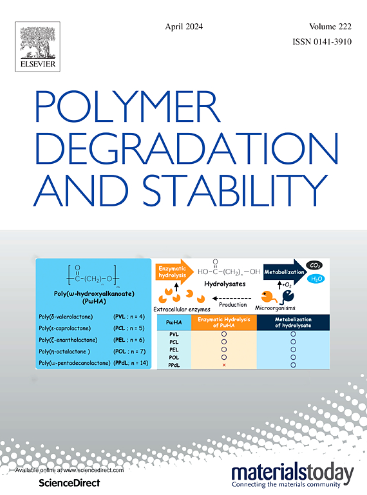The synthesis and properties of an intumescent zinc-chelated organometallic flame retardant
IF 6.3
2区 化学
Q1 POLYMER SCIENCE
引用次数: 0
Abstract
Organometallic flame retardants (OFRs) are currently attracting intensive attention. Here, we synthesized a new zinc-chelated OFR, ZnDSi, which was incorporated with phosphorus, silicon, and nitrogen functional moieties. The resulting ZnDSi exhibited strong intumescent properties upon heating and demonstrated high thermal stability, with a decomposition temperature (Td, 5 %) of 349 °C, making it suitable for the melt-processing of most engineering plastics. Comparative experiments demonstrated that the chelated zinc converted the properties of the resultant OFR, including its intumescence, thermostability and hydrophobicity. The ZnDSi was tested in polyamide 66 (PA66) for the flame-retardant properties. Incorporating 10 wt% of ZnDSi into PA66 attained a limiting oxygen index of 29.1 %, accompanied by the reduction of the peak heat release rate by 35.0 % and total heat release by 28.2 % when compared to the pure PA66 sample, according to the cone calorimeter tests. Mechanism investigation was conducted to probe into the interactions between zinc and organic components through a custom apparatus for pyrolytic gas analysis, and it was found that zinc could reduce the soot release by suppressing the formation of the soot precursors during the pyrolysis. This work contributes to a deeper understanding of how metal elements function in OFR systems, which may conduce to developing OFRs with advanced performance.
一种膨胀型锌螯合有机金属阻燃剂的合成与性能
本文章由计算机程序翻译,如有差异,请以英文原文为准。
求助全文
约1分钟内获得全文
求助全文
来源期刊

Polymer Degradation and Stability
化学-高分子科学
CiteScore
10.10
自引率
10.20%
发文量
325
审稿时长
23 days
期刊介绍:
Polymer Degradation and Stability deals with the degradation reactions and their control which are a major preoccupation of practitioners of the many and diverse aspects of modern polymer technology.
Deteriorative reactions occur during processing, when polymers are subjected to heat, oxygen and mechanical stress, and during the useful life of the materials when oxygen and sunlight are the most important degradative agencies. In more specialised applications, degradation may be induced by high energy radiation, ozone, atmospheric pollutants, mechanical stress, biological action, hydrolysis and many other influences. The mechanisms of these reactions and stabilisation processes must be understood if the technology and application of polymers are to continue to advance. The reporting of investigations of this kind is therefore a major function of this journal.
However there are also new developments in polymer technology in which degradation processes find positive applications. For example, photodegradable plastics are now available, the recycling of polymeric products will become increasingly important, degradation and combustion studies are involved in the definition of the fire hazards which are associated with polymeric materials and the microelectronics industry is vitally dependent upon polymer degradation in the manufacture of its circuitry. Polymer properties may also be improved by processes like curing and grafting, the chemistry of which can be closely related to that which causes physical deterioration in other circumstances.
 求助内容:
求助内容: 应助结果提醒方式:
应助结果提醒方式:


